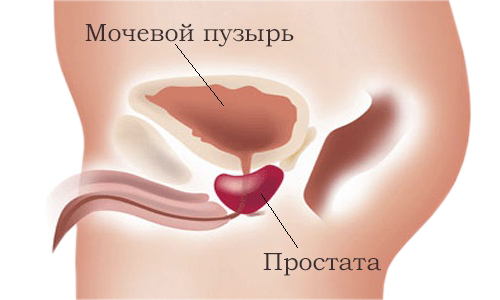Any cystic formation is a kind of cavity in the thickness of normal tissues filled with a liquid. Such formations can appear in any organs. The prostate, unfortunately, is no exception. The prostate cyst is considered a fairly common clinical case, as it is diagnosed in a fifth of the male population of the planet. In rare cases, pathology differs in an innate character, in others it is acquired due to various glandular pathologies like prostatitis. Most often cystic prostate cancer develops to the mature and elderly patients.

Classification of prostatic cysts
The prostatic cyst is congenital and acquired.
- Congenital formations are localized at the base of the gland and are characterized by spindle-like or drop-shaped form. The size is not more than 4 cm, thin-walled and homogeneous structure, sometimes have several chambers. They often develop in parallel with hypospadias and cryptorchidism;
- Acquired cysts are predominantly single, not more than 2.5 cm. Although clinical cases are known, when a similar cyst was placed around a liter of liquid and grew to an incredible size. Inside the formation often there is brownish or yellow-gray, less often colorless content of a viscous consistency.
In addition, prostatic cysts are classified as follows:
- Multiple and single;
- Infectious and non-infectious. Infectious are formed as a result of inflammatory processes involving pathogenic microorganisms, and non-infectious - against inflammation caused by physiology;
- Inflammatory or non-inflammatory. For the former, the previous pathology is characterized by a purulent inflammatory process, while the latter develop without it;
- False and true. In the case of a false shape, the image of the cyst takes a glandular lobule enlarged and filled with contents. With a true cyst in the glandular tissue between the lobules, cavities with a liquid are formed, as a filler may be prostatic juice, exudate or something else.
Why are similar formations of
Generally, the appearance of a prostatic secretion in the prostate and the violation of the outflow of prostatic juice from the gland results in the appearance of a prostatic cyst. In addition, the likelihood of its occurrence is significantly greater in men:
- Leading too active or irregular sexual life or not leading it at all;
- With unfavorable professional conditions like pulling heavy weights, vibration;
- Having prostate adenoma, prostatitis;
- Suffering from obstruction of the prostatic ducts due to their squeezing with a large concrement, tumor or overgrown fibrous tissue.
If we talk about congenital prostatic cysts, they are formed against the background of an irregular formation of Muller's canals and are often combined with a different anomalous structure of the scrotum or penis.
How the prostate cyst is manifested
Quite often there are clinical cases when the prostate cyst develops completely asymptomatically, and is detected accidentally during a physical examination or a doctor's call for other reasons. But in some cases it still has a certain symptomatology. Among the characteristic manifestations of education the most vivid and common are:
- Difficulty with urination at the very beginning of the process of emptying the bladder;
- Increase in desires, especially at night;
- Minor temperature increase;
- Erection loss, rapid ejaculation;
- Pain syndrome in the low-tidal region;
- Attenuation of the urinary stream;
- Discomfort in the process of ejaculation;
- Erectile dysfunction.
If an infection gets into the cyst, the process of suppuration begins, an abscess occurs, tissue proliferation begins, leading to sclerosis and atrophy of the prostate. Cystic formation occurs in any part of the prostate, can even block the lumen of the urethra or rectum.
Attention! If suddenly there are symptoms like severe soreness, discomfort in the perineum and rectum, urination disorders, then you should go to the urologist, since such a picture can indicate the development of suppuration in the prostate cyst.
Such a clinical picture is typical for most pathologies of the male genitourinary and reproductive area, so a qualified urologist should be diagnosed. Professional diagnostics involves the use of such research techniques as transrectal ultrasound of the prostate, finger diagnosis through the rectum, puncture and laboratory tests of sperm, blood, prostatic juice and urine.
Therapy methods of
Treatment of such an education is caused by a variety of factors: symptoms, cyst types, inflammation and other related disorders, etc. In general, the prostate cyst suggests such treatment options as observation, puncture or surgery. The doctor chooses observational tactics in case of accidental detection of pathology, when the cyst develops without any manifestations, has small dimensions and does not give the patient uncomfortable sensations. In some cases, the patient is prescribed taking medications, which the doctor chooses in accordance with the cause of cystic education.
For reference. Puncture therapy is considered the safest and most effective because of the simplicity and minimally invasive procedure.
In situations where the formation becomes large, causes micturition and erectile dysfunction, a puncture is indicated. For this purpose, the cystic cavity is pierced, and then a special preparation intended for gluing the walls of the formation is introduced into it. If the formation is very large, it begins to fester, then they resort to a surgical operation involving removal. Depending on the location and parameters of the formation, removal is carried out by the open method through the peritoneum, transurethral, transrectal or through the perineum.
Prevention
To avoid the formation of a prostatic cyst, it is necessary to undergo the necessary treatment in case of urological and other pathologies, avoid hypothermia, and not abuse alcohol. Even with minor abnormalities and mild symptoms, you need to contact a urologist.
Attention! Categorically, it is not advisable to postpone the treatment of cystic prostate formation, as it is fraught with spontaneous dissection, suppuration, retention of urine, vascular compression, etc.
Men 40-45 years of age and older must take the rule that an annual urological examination is necessary, since this agethe risk of developing "male" diseases is significantly increased. Compliance with these simple recommendations will reduce the likelihood of developing a prostate cyst and other pathologies of the male reproductive and genitourinary system.



